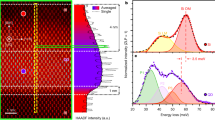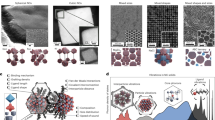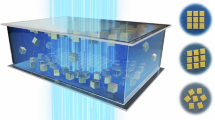Abstract
Geometry and topology endow mechanical frames with unusual properties from shape morphing to phonon wave manipulation, enabling emerging technologies. Despite important advances in macroscopic frames, the realization and phonon imaging of nanoscale mechanical metamaterials has remained challenging. Here we extend the principle of topologically engineered mechanical frames to self-assembled nanoparticle lattices, resolving phonon dynamics using liquid-phase transmission electron microscopy. The vibrations of nanoparticles in Maxwell lattices are used to measure properties that have been difficult to obtain, such as phonon band structures, nanoscale spring constants and nonlinear lattice deformation paths. Studies of five different lattices reveal that these properties are modulated by nanoscale colloidal interactions. Our discrete mechanical model and simulations capture these interactions and the critical role of effects beyond nearest neighbours, bridging mechanical metamaterials with nanoparticle self-assembly. Our study provides opportunities for understanding and manufacturing self-assembled nanostructures for phonon manipulation, offering solution processability, transformability and emergent functions at underexplored scales of length, frequency and energy density.
This is a preview of subscription content, access via your institution
Access options
Access Nature and 54 other Nature Portfolio journals
Get Nature+, our best-value online-access subscription
$32.99 / 30 days
cancel any time
Subscribe to this journal
Receive 12 print issues and online access
$259.00 per year
only $21.58 per issue
Buy this article
- Purchase on SpringerLink
- Instant access to full article PDF
Prices may be subject to local taxes which are calculated during checkout





Similar content being viewed by others
Data availability
The data that support the findings of this study are available via GitHub at https://github.com/chenlabUIUC/Phonon-mapping-nanoscopy.
Code availability
The codes for the PMN analysis and BD simulations developed in this study are available via GitHub at https://github.com/chenlabUIUC/Phonon-mapping-nanoscopy.
References
Versaci, A. & Cardaci, A. The MAXXI Museum in Rome: an integrated survey experience for the restoration of contemporary architecture. Int. Arch. Photogramm. Remote Sens. Spat. Inf. Sci. 42, 187–194 (2017).
Hajiesmaili, E., Larson, N. M., Lewis, J. A. & Clarke, D. R. Programmed shape-morphing into complex target shapes using architected dielectric elastomer actuators. Sci. Adv. 8, eabn9198 (2022).
Ni, X., Yves, S., Krasnok, A. & Alu, A. Topological metamaterials. Chem. Rev. 123, 7585–7654 (2023).
Xie, B. et al. Higher-order band topology. Nat. Rev. Phys. 3, 520–532 (2021).
Xu, Z., Tong, J., Cui, T. J., Chang, J. & Sievenpiper, D. F. Near-field chiral excitation of universal spin-momentum locking transport of edge waves in microwave metamaterials. Adv. Photonics 4, 046004 (2022).
Maxwell, J. C. On the calculation of the equilibrium and stiffness of frames. Lond. Edinb. Dublin Philos. Mag. 27, 294–299 (1864).
Mao, X. & Lubensky, T. C. Maxwell lattices and topological mechanics. Annu. Rev. Condens. Matter Phys. 9, 413–433 (2018).
Coulais, C., Kettenis, C. & van Hecke, M. A characteristic length scale causes anomalous size effects and boundary programmability in mechanical metamaterials. Nat. Phys. 14, 40–44 (2017).
Rocklin, D. Z., Zhou, S., Sun, K. & Mao, X. Transformable topological mechanical metamaterials. Nat. Commun. 8, 14201 (2017).
Chen, W. et al. Stiff isotropic lattices beyond the Maxwell criterion. Sci. Adv. 5, eaaw1937 (2019).
Li, Q. et al. Mechanical nanolattices printed using nanocluster-based photoresists. Science 378, 768–773 (2022).
Groß, M. F. et al. Tetramode metamaterials as phonon polarizers. Adv. Mater. 35, e2211801 (2023).
Hahn, V. et al. Two-step absorption instead of two-photon absorption in 3D nanoprinting. Nat. Photon. 15, 932–938 (2021).
Boles, M. A., Engel, M. & Talapin, D. V. Self-assembly of colloidal nanocrystals: from intricate structures to functional materials. Chem. Rev. 116, 11220–11289 (2016).
Michelson, A. et al. Three-dimensional visualization of nanoparticle lattices and multimaterial frameworks. Science 376, 203–207 (2022).
Li, Y. et al. Ultrastrong colloidal crystal metamaterials engineered with DNA. Sci. Adv. 9, eadj8103 (2023).
Michelson, A., Flanagan, T. J., Lee, S.-W. & Gang, O. High-strength, lightweight nano-architected silica. Cell Rep. Phys. Sci. 4, 101475 (2023).
Jansen, M., Tisdale, W. A. & Wood, V. Nanocrystal phononics. Nat. Mater. 22, 161–169 (2023).
Yazdani, N. et al. Nanocrystal superlattices as phonon-engineered solids and acoustic metamaterials. Nat. Commun. 10, 4236 (2019).
Gorishnyy, T., Ullal, C. K., Maldovan, M., Fytas, G. & Thomas, E. L. Hypersonic phononic crystals. Phys. Rev. Lett. 94, 115501 (2005).
Cheng, W., Wang, J., Jonas, U., Fytas, G. & Stefanou, N. Observation and tuning of hypersonic bandgaps in colloidal crystals. Nat. Mater. 5, 830–836 (2006).
Still, T. et al. Simultaneous occurrence of structure-directed and particle-resonance-induced phononic gaps in colloidal films. Phys. Rev. Lett. 100, 194301 (2008).
Liu, Z. et al. Locally resonant sonic materials. Science 289, 1734–1736 (2000).
Yuan, Y. et al. Cu-catalyzed synthesis of CdZnSe–CdZnS alloy quantum dots with highly tunable emission. Chem. Mater. 31, 2635–2643 (2019).
Liu, M. et al. Colloidal quantum dot electronics. Nat. Electron. 4, 548–558 (2021).
Ma, J., Zhou, D., Sun, K., Mao, X. & Gonella, S. Edge modes and asymmetric wave transport in topological lattices: experimental characterization at finite frequencies. Phys. Rev. Lett. 121, 094301 (2018).
Arzash, S., Sharma, A. & MacKintosh, F. C. Mechanics of fiber networks under a bulk strain. Phys. Rev. E 106, L062403 (2022).
Gadre, C. A. et al. Nanoscale imaging of phonon dynamics by electron microscopy. Nature 606, 292–297 (2022).
Keim, P., Maret, G., Herz, U. & von Grunberg, H. H. Harmonic lattice behavior of two-dimensional colloidal crystals. Phys. Rev. Lett. 92, 215504 (2004).
Mao, X., Chen, Q. & Granick, S. Entropy favours open colloidal lattices. Nat. Mater. 12, 217–222 (2013).
Ou, Z., Wang, Z., Luo, B., Luijten, E. & Chen, Q. Kinetic pathways of crystallization at the nanoscale. Nat. Mater. 19, 450–455 (2020).
Zhu, G. et al. Self-similar mesocrystals form via interface-driven nucleation and assembly. Nature 590, 416–422 (2021).
Yuk, J. M. et al. High-resolution EM of colloidal nanocrystal growth using graphene liquid cells. Science 336, 61–64 (2012).
Batista, C. A., Larson, R. G. & Kotov, N. A. Nonadditivity of nanoparticle interactions. Science 350, 1242477 (2015).
Kim, H. et al. Direct observation of polymer surface mobility via nanoparticle vibrations. Nat. Commun. 9, 2918 (2018).
Rocklin, D. Z., Hsiao, L., Szakasits, M., Solomon, M. J. & Mao, X. Elasticity of colloidal gels: structural heterogeneity, floppy modes, and rigidity. Soft Matter 17, 6929–6934 (2021).
Damasceno, P. F., Engel, M. & Glotzer, S. C. Predictive self-assembly of polyhedra into complex structures. Science 337, 453–457 (2012).
Santos, P. J., Gabrys, P. A., Zornberg, L. Z., Lee, M. S. & Macfarlane, R. J. Macroscopic materials assembled from nanoparticle superlattices. Nature 591, 586–591 (2021).
Elbert, K. C. et al. Anisotropic nanocrystal shape and ligand design for co-assembly. Sci. Adv. 7, eabf9402 (2021).
Gantapara, A. P., de Graaf, J., van Roij, R. & Dijkstra, M. Phase diagram and structural diversity of a family of truncated cubes: degenerate close-packed structures and vacancy-rich states. Phys. Rev. Lett. 111, 015501 (2013).
Avendaño, C. & Escobedo, F. A. Phase behavior of rounded hard-squares. Soft Matter 8, 4675 (2012).
Henkes, S., Brito, C. & Dauchot, O. Extracting vibrational modes from fluctuations: a pedagogical discussion. Soft Matter 8, 6092–6109 (2012).
Shen, H. et al. Single particle tracking: from theory to biophysical applications. Chem. Rev. 117, 7331–7376 (2017).
Lewis, D. J., Carter, D. J. D. & Macfarlane, R. J. Using DNA to control the mechanical response of nanoparticle superlattices. J. Am. Chem. Soc. 142, 19181–19188 (2020).
Wei, J. et al. Direct imaging of atomistic grain boundary migration. Nat. Mater. 20, 951–955 (2021).
Zhu, Q. et al. In situ atomistic observation of disconnection-mediated grain boundary migration. Nat. Commun. 10, 156 (2019).
Song, M. et al. Oriented attachment induces fivefold twins by forming and decomposing high-energy grain boundaries. Science 367, 40–45 (2020).
Hu, H., Ruiz, P. S. & Ni, R. Entropy stabilizes floppy crystals of mobile DNA-coated colloids. Phys. Rev. Lett. 120, 048003 (2018).
Stukowski, A., Albe, K. & Farkas, D. Nanotwinned fcc metals: Strengthening versus softening mechanisms. Phys. Rev. B 82, 224103 (2010).
Jacobs, D. J., Rader, A. J., Kuhn, L. A. & Thorpe, M. F. Protein flexibility predictions using graph theory. Proteins Struct. Funct. Bioinform. 44, 150–165 (2001).
Charara, M., McInerney, J., Sun, K., Mao, X. & Gonella, S. Omnimodal topological polarization of bilayer networks: Analysis in the Maxwell limit and experiments on a 3D-printed prototype. Proc. Natl Acad. Sci. USA 119, e2208051119 (2022).
O’Brien, M. N., Jones, M. R., Brown, K. A. & Mirkin, C. A. Universal noble metal nanoparticle seeds realized through iterative reductive growth and oxidative dissolution reactions. J. Am. Chem. Soc. 136, 7603–7606 (2014).
Ye, X., Zheng, C., Chen, J., Gao, Y. & Murray, C. B. Using binary surfactant mixtures to simultaneously improve the dimensional tunability and monodispersity in the seeded growth of gold nanorods. Nano Lett. 13, 765–771 (2013).
Schneider, C., Rasband, W. & Eliceiri, K. NIH Image to ImageJ: 25 years of image analysis. Nat. Methods 9, 671–675 (2012).
Falk, T. et al. U-Net: deep learning for cell counting, detection, and morphometry. Nat. Methods 16, 67–70 (2019).
Yao, L., Ou, Z., Luo, B., Xu, C. & Chen, Q. Machine learning to reveal nanoparticle dynamics from liquid-phase TEM videos. ACS Cent. Sci. 6, 1421–1430 (2020).
Acknowledgements
Experiments and theoretical modelling for the equilibrium NP self-assemblies in this work were supported by the Office of Naval Research under award number MURI N00014-20-1-2479 (C.Q., E.S., J.L., X.M. and Q.C.). Validation analysis of non-equilibrium self-assemblies were supported by US National Science Foundation under Cooperative Agreement No. 2243104, “Center for Complex Particle Systems (COMPASS)” Science and Technology Center (P.P. and Q.C.). The BD simulation effort of this work integrated with experiment was supported by the Defense Established Program to Stimulate Competitive Research (DEPSCoR) grant no. FA9550-20-1-0072 (Z.M. and W.P.) and Army Research Office grant no. W911NF2310256 (Z.M., Q.C. and W.P.). We thank Nicholas A. Kotov and Roberto Merlin for helpful discussions.
Author information
Authors and Affiliations
Contributions
C.Q. and Q.C. designed the experiments. C.Q. and B.L. performed the experiments. C.Q., L.Y., C.L. and Q.C. carried out the CG modelling and single-particle tracking analysis. E.S. and X.M. developed the discrete mechanical model and theory. C.Q., J.L., P.P. and E.S. performed the PMN analysis. Z.M. and W.P. performed the BD simulations with ML-based inter-NP interaction modelling. C.Q. and Q.C. wrote the first draft of the paper. All authors contributed to the writing of the paper. Q.C., X.M. and W.P. supervised the work.
Corresponding authors
Ethics declarations
Competing interests
The authors declare no competing interests.
Peer review
Peer review information
Nature Materials thanks the anonymous reviewers for their contribution to the peer review of this work.
Additional information
Publisher’s note Springer Nature remains neutral with regard to jurisdictional claims in published maps and institutional affiliations.
Supplementary information
Supplementary Information
Supplementary Text, Notes 1–14, Tables 1–15, Figs. 1–31, captions for Supplementary Videos 1–5 and References.
Supplementary Video 1
Synchronized liquid-phase TEM video showing the self-assembly of a rhombic Maxwell lattice from colloidal gold nanocubes. Left, the liquid-phase TEM video with tracked centroid positions of individual cubes (yellow) overlaid. Right, the bond network constructed from the centroid positions. Rhombuses are coloured according to θtilt. The video was captured at I = 22 mM; playback is at 10 f.p.s., real time. Dose rate: 10.9 e− Å−2 s−1. Scale bars, 300 nm.
Supplementary Video 2
BD simulation of square-to-rhombic lattice relaxation. The simulation starts from an initial configuration of 81 cubes organized on a two-dimensional square lattice at I = 22 mM. Left: the mean θtilt (± s.d.) of the BD system (as shown on the right) plotted on the inter-NP interaction energy curve derived from CG interaction modelling to trace the relaxation dynamics from a metastable square lattice to the stable rhombic lattice. Right: BD simulation of the cube assembly. Cubes are represented by black squares. Rhombuses are coloured according to θtilt. After ~1,500 simulation steps, the system relaxes into a rhombic lattice of θ = 80°.
Supplementary Video 3
Workflow of PMN analysis. The liquid-phase TEM video was captured at I = 22 mM; playback is at 10 f.p.s., real time. Dose rate: 10.9 e− Å−2 s−1. Scale bars, 200 nm.
Supplementary Video 4
Liquid-phase TEM videos of the Maxwell lattice regions for the PMN analysis. Two selected liquid-phase TEM video regions of different ionic strengths used for the PMN analysis, overlaid with tracked centroid positions and trajectories of single NPs after drift correction (coloured according to the elapsed time). Dose rates: 10.9 e− Å−2 s−1 for I = 27 mM; 14.4 e− Å−2 s−1 for I = 110 mM. Scale bars, 100 nm.
Supplementary Video 5
Liquid-phase TEM video showing deformation paths of TB migration. Liquid-phase TEM video (left) overlaid with tracked centroid positions of particles (yellow), synchronized with the bond network and rhombuses coloured according to θtilt (right, same colour scale as in Fig. 5a). TBs are noted by the green lines to highlight the migration. The video is captured using a K2 direct electron detector camera in IS mode at 400 f.p.s.; playback is at 10 f.p.s., which is 0.05 × real time. Dose rate: 10.2 e− Å−2 s−1. I = 22 mM. Scale bars, 200 nm.
Rights and permissions
Springer Nature or its licensor (e.g. a society or other partner) holds exclusive rights to this article under a publishing agreement with the author(s) or other rightsholder(s); author self-archiving of the accepted manuscript version of this article is solely governed by the terms of such publishing agreement and applicable law.
About this article
Cite this article
Qian, C., Stanifer, E., Ma, Z. et al. Nanoscale phonon dynamics in self-assembled nanoparticle lattices. Nat. Mater. 24, 1616–1625 (2025). https://doi.org/10.1038/s41563-025-02253-3
Received:
Accepted:
Published:
Issue date:
DOI: https://doi.org/10.1038/s41563-025-02253-3



